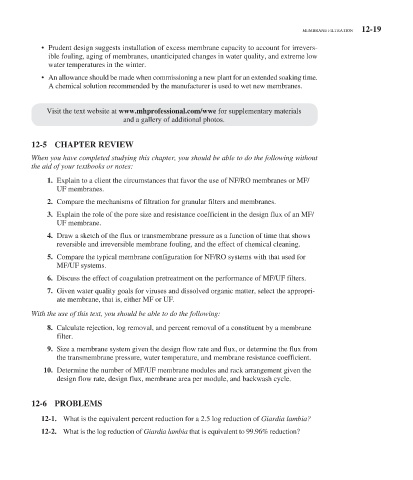Page 502 - Water and wastewater engineering
P. 502
MEMBRANE FILTRATION 12-19
• Prudent design suggests installation of excess membrane capacity to account for irrevers-
ible fouling, aging of membranes, unanticipated changes in water quality, and extreme low
water temperatures in the winter.
• An allowance should be made when commissioning a new plant for an extended soaking time.
A chemical solution recommended by the manufacturer is used to wet new membranes.
Visit the text website at www.mhprofessional.com/wwe for supplementary materials
and a gallery of additional photos.
12-5 CHAPTER REVIEW
When you have completed studying this chapter, you should be able to do the following without
the aid of your textbooks or notes:
1. Explain to a client the circumstances that favor the use of NF/RO membranes or MF/
UF membranes.
2. Compare the mechanisms of filtration for granular filters and membranes.
3. Explain the role of the pore size and resistance coefficient in the design flux of an MF/
UF membrane.
4. Draw a sketch of the flux or transmembrane pressure as a function of time that shows
reversible and irreversible membrane fouling, and the effect of chemical cleaning.
5. Compare the typical membrane configuration for NF/RO systems with that used for
MF/UF systems.
6. Discuss the effect of coagulation pretreatment on the performance of MF/UF filters.
7. Given water quality goals for viruses and dissolved organic matter, select the appropri-
ate membrane, that is, either MF or UF.
With the use of this text, you should be able to do the following:
8. Calculate rejection, log removal, and percent removal of a constituent by a membrane
filter.
9. Size a membrane system given the design flow rate and flux, or determine the flux from
the transmembrane pressure, water temperature, and membrane resistance coefficient.
10. Determine the number of MF/UF membrane modules and rack arrangement given the
design flow rate, design flux, membrane area per module, and backwash cycle.
12-6 PROBLEMS
12-1. What is the equivalent percent reduction for a 2.5 log reduction of Giardia lambia?
12-2. What is the log reduction of Giardia lambia that is equivalent to 99.96% reduction?

